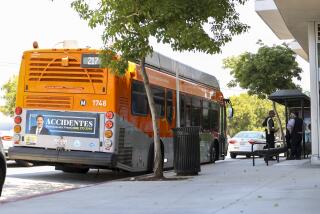Changes Due for Rail Bottleneck
- Share via
Beneath the Santa Susana Mountains lies what is perhaps the worst bottleneck for train service on the Coast Main Line, the line that serves passenger and freight trains running from San Diego to San Luis Obispo.
The 1.25-mile span of the narrow, decrepit tunnel has connected Simi Valley to the Los Angeles Basin since 1905.
But for the first time the trains, which must pass through the tunnel as slowly as 15 mph, will be able to communicate with the outside world.
The U.S. Department of Housing and Urban Development has approved a $250,000 grant to add antennas and wiring that will enable trains passing through the tunnel to maintain radio contact with train dispatchers.
“Being able to improve the communications through there is a real improvement,” said Mary Travis, manager of passenger rail programs for the Ventura County Transportation Commission.
“It’s a one-way tunnel. You don’t want to have any surprises on one side or another.”
The grant is just a drop in the bucket among the extensive repairs sought by local transportation agencies for the 94-year-old tunnel.
The structure, known as Tunnel 26, needs about $20 million in improvements to allow trains to go through without slowing down, transportation officials said.
An improved tunnel would reduce by 10 minutes the time it takes a commuter train to travel between Simi Valley and Union Station in downtown Los Angeles, transportation officials said, making it a more attractive alternative for commuters.
Trains must now slow from 79 mph to as little as 15 mph when passing through thetunnel.
Tunnel 26 has also long been viewed as a possible hazard if a passenger train broke down inside the tunnel.
It has no lighting or ventilation, along with aging tracks and concrete lining and a dirt floor that turns into mud during heavy rains, factors that have prompted local officials at all levels to press for funds to improve the tunnel.
On an average weekday, about 30 trains pass through the tunnel, split three ways between two passenger services--Metrolink and Amtrak--and Union Pacific Railroad freight trains, transportation officials said.
More to Read
Sign up for Essential California
The most important California stories and recommendations in your inbox every morning.
You may occasionally receive promotional content from the Los Angeles Times.










